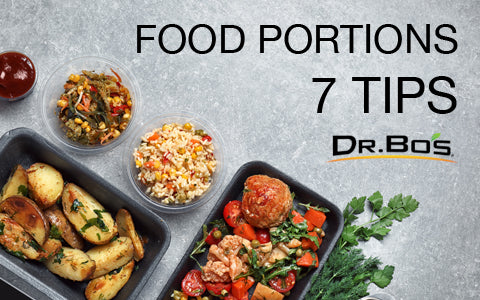It can be tough to gauge portions accurately when eating, especially when our mouths are bigger than our stomachs or when eating out! So many health complications can develop by eating too much, like diabetes, weight, constipation, stomach pains, and more. That's why it's SO IMPORTANT that we always keep good portion size in mind when eating.
Use these 7 tips to get started:
1. Eat All 3 Major Meals
Breakfast, lunch and dinner are famous for a reason. They sustain us for the entire day. If you're starving, you're more likely to eat an extra-large portion of food. For most people, the best plan is to eat three well-designed meals and one snack during the day. This way you're not starving, you know what's coming, and you can have a good schedule.
2. Get a Food Scale
We all like to just "eye ball it" when it comes to measuring out our food. Though, doing that only leaves the door open to inconsistencies and being over or under fed, which only creates more unwanted weight or hunger. A simple food scale from your local store can help measure out those couple ounces of meat or potatoes you're looking to limit. Once you have it, it's easy to incorporate. Plus, it's a good little accountability device.
3. Know Your Backup Measures
No one's going to bring a food scale when they're out at a restaurant. It's just not practical. Just keep in mind that 3 ounces of lean meat is about the size of a deck of cards or thick wallet, and a cup of breakfast cereal is about the size of a fist, tennis ball, or baseball. These come in pretty handy when traveling or in a new restaurant.
4. Serving Size vs. Portion Size
Is there a difference? Yes! Remember all those numbers on the side of a box of food called "Nutritional Facts"? Those are there for a reason. One of which is to help you know what a serving size is for that particular food. Also, it really makes you aware exactly how much sugar, carbs, fat, etc. are in a single serving. If your portion size is bigger than the serving size on the box or jar like for instance twice as big, then you'll have to double all those numbers on the box. You might be surprised when you look at that!
5. Use Your Plates and Bowls as Portion Controllers
If you have large dinner plates, small plates, different sized bowls and more, then you have your very own portion control devices. You can even find plates and bowls that have lines drawn out offering portion sizes to help with this. All it takes is remembering that.
6. Incorporate Good "Eating Out" Habits
Whey you eat your meal, first eat all the vegetables and greens. This is where we get our nutrition and is the main food that the body wants. Also, know that restaurants specialize in big-portions - a piece of meat like steak is 3-4 servings, so you could divide that up over a few meals. Lastly, when you order, tell the server to only serve you half the meal and put the other half in a to-go box.
7. Have a Plan
Keep track of what you eat, so that you can see any trends that may happen when you gain or lose weight. Also, this will help keep you accountable. Plan out your meals, so that you know what's to come and you won't get off track. Most people deciding what to eat on a whim will order or eat too much, or even reach for that extra dessert.

